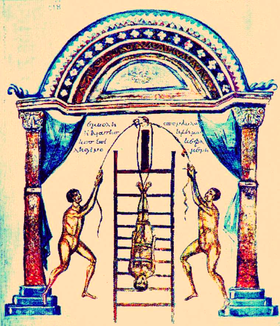Traction (orthopedics)
| Traction (orthopedics) | |
|---|---|
| Intervention | |

|
|
| ICD-9-CM | 93.4 |
| MeSH | D014143 |
In orthopedic medicine, traction refers to the set of mechanisms for straightening broken bones or relieving pressure on the spine and skeletal system. There are two types of traction: skin traction and skeletal traction.
Traction procedures are largely replaced now by more modern techniques, but certain approaches are still used today:
Although the use of traction has decreased over the years, an increasing number of orthopaedic practitioners are using traction in conjunction with bracing (see Milwaukee brace).
Harrison et al. (2005) found that mirror image (opposite posture) postural corrective exercises and a new method of trunk-list traction resulted in 50% reduction in trunk list and were associated with nearly resolved pain intensity in this patient population. These researchers felt that their findings warranted further study in the conservative treatment of chronic low back pain and spinal disorders.
Spinal traction as a means of spinal decompression is often applied without directly touching bones as other methods of traction do. This is sometimes isolated inside-out by inflatable girdles or use of the transversus abdominis muscle. It is also done in conjunction with thigh-supported flexed-hip traction (inversion chairs, back hyperextensions) or done in conjunction with whole-leg traction (boots, tables) via inverted forms of suspension.
Traction of the spine (except the cervical) also occurs with upright suspension of the body from the arms, such as with pull-ups (exercise), dips (exercise), captain's chair, chinnings (chin up exercise) or other fitness movements with the feet dangling.
The purpose of traction is to:
In most cases traction is only one part of the treatment plan of a patient needing such therapy. The physician's order will contain:
The physician is typically responsible for initial application of traction and weights while the adjustment or removal (to perform ablution functions / physiotherapy) of skeletal traction weights will be based on the doctors charted plan.
...
Wikipedia
